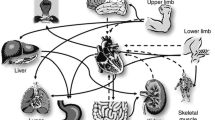Summary
Pretreatment with pertussis toxin (0.5 and 1.0 μg/animal, i. c. v., seven days prior to testing) reversed the reduction in locomotor activity in the holeboard test caused by administration of the alpha2-adrenoceptor agonist, medetomidine (0.1 mg/kg, i. p.). Intrinsic behavioral effects of pertussis toxin treatment were also observed, these included a reduction in exploratory head-dipping and an increase in locomotor activity. These doses of pertussis toxin also reduced the ataxia induced by a 2.4 g/kg dose of ethanol. Pertussis toxin treated animals also exhibited a diminished hypothermic response to ethanol (2 g/kg), although the pertussis toxin treated animals had lower body temperatures prior to ethanol administration compared to sham treated animals. Neither the behavioral effect of pertussis holotoxin in the holeboard nor its effects on reversing medetomidine hypolocomotion or ethanol-induced ataxia were seen following administration of the binding oligomer of pertussis toxin which binds to the cell membrane but does not possess the enzymatically active subunit. These findings implicate mechanisms involving pertussis toxin sensitive G-proteins in modulating some behavioral and physiological effects of ethanol.
Similar content being viewed by others
References
Allan AM, Harris RA (1989) A new alcohol antagonist: phaclofen. Life Sci 45: 1771–1779
Bloom FE (1975) The role of cyclic nucleotides in central synaptic transmission. Rev Physiol Pharmacol 74:1–103
Bucher T, Redetzki H (1951) Eine photometrische Bestimmung von Äthylalkohol auf fermentativem Wege. Klin Wochenschr 29:615–621
Burns DL (1988) Subunit structure and enzymatic activity of pertussis toxin. Microbiol Sci 5:285–287
Cavicchini E, Spampinato S, Ferri S (1990) Gi proteins and calcium in dynorphin-induced hypothermia and behavior. Eur J Pharmacol 180:357–360
Clark M, Dar MS (1988) Mediation of acute ethanol-induced motor disturbances by cerebellar adenosine in rats. Pharmacol Biochem Behav 30:155–161
Cockcroft S, Gomperts BD (1985) Role of guanine nucleotide binding protein in the activation of polyphosphoinositide phosphodiesterase. Nature 314:534–536
Cooper DM, Bier-Laning CM, Halford MK, Ahlijanian MK, Zahniser NR (1986) Dopamine, acting through D-2 receptors, inhibits rat striatal adenylate cyclase by a GTP-dependent process. Mol Pharmacol 29:113–119
Dar MS, Jones M, Close G, Mustafa SJ, Wooles WR (1987) Behavioral interactions of ethanol and methylxanthines. Psychopharmacology (Berlin) 91:1–4
De Sarro GB, Bagetta G, Ascioti C, Libri V, Nistico G (1989) Effects of pertussis toxin on the behavioural and ECoG spectrum changes induced by clonidine and yohimbine after their microinfusion into the locus coeruleus. Br J Pharmacol 96:59–64
Durcan MJ, Hilakivi LA, Lister RG, Linnoila M (1989a) Attenuation of the effects of ethanol on social behavior by alpha2-adrenoceptor antagonsits. Alcohol 6:189–192
Durcan MJ, Lister RG, Linnoila M (1989b) Interactions of alpha2-adrenoceptor antagonists with medetomidine and with ethanol in a holeboard test. Neuropharmacology 28:275–281
Durcan MJ, Lister RG, Linnoila M (1989c) Behavioral effects of alpha2 adrenoceptor antagonists and their interactions with ethanol in tests of locomotion, exploration and anxiety in mice. Psychopharmacology (Berlin) 97:189–193
Durcan MJ, Lister RG, Linnoila M (1990) The hypothermic and ataxic effects of ethanol: Evidence for modulation by central alpha2-adrenoceptors. Society for Neuroscience Abstracts 16:258
Durcan ML Morgan PF (1991) Intracerebroventricular pertussis toxin enhances sensitivity to NMDA-induced seizures in mice. Eur J Pharmacol, in press
Durcan MJ, Wozniak KM, Lister RG, Linnoila M (1989d) Antagonism of the hypothermic effects of ethanol by alpha2-adrenoceptor blockers, atipamezole and idazoxan. Eur J Pharmacol 166:381–386
Gilman AG (1987) G-proteins: transducers of receptor-generated signals. Ann Rev Biochem 56:615
Harrington MA, Oksenberg D, Peroutka SJ (1988) 5-Hydroxytryptamine 1 receptors are linked to a Gi-adenylate cyclase complex of rat hippocampus. Eur J Pharmacol 154:95–98
Holz GG, Rane SG, Dunlap K (1986) GTP-binding proteins mediate transmitter inhibition of voltage-dependent calcium channels. Nature 319:670–672
Ishii S (1982) Subunit structure of islet-activating protein, pertussis toxin, in conformity with the A-B model. Biochemistry 21:5516–5522
Lister RG, Durcan MJ, Nutt DJ, Linnoila M (1989) Attenuation of ethanol intoxication by alpha-2 adrenoceptor antagonists. Life Sci 44:111–119
Majchrowicz E (1975) Induction of physical dependence upon ethanol and the associated behavioral changes. Psychopharmacology 43:245–254
Nomura Y, Kawata K, Kitamura Y, Watanabe H (1987) Effects of pertussis toxin on the alpha2-adrenoceptor-inhibitory GTP-binding protein-adenylate cyclase system in rat brain: pharmacological and neurochemical studies. Eur J Pharmacol 134:123–129
Olianas MC, Onabi P, Neff HN, Costa E (1983) Adenylate cyclase activity of synaptic membranes from rat striatum: Inhibition by muscarinic receptor agonists. Mol Pharmacol 23:393–398
Schoffelmeer ANM, Hansen HA, Stoff JC, Mulder AH (1986) Blockade of D-2 dopamine receptors strongly enhances the potency of enkephalins to inhibit dopamine-sensitive adenylate cyclase in rat neostriatum: involvement of sigma- and muopioid receptors. J Neurosci 6:2235–2239
Schramm M, Selinger Z (1984) Message transmission: receptor controlled adenylate cyclase system. Science 225:1350–1356
Tamura M, Nogimori K, Murai S, Yajima M, Ito K, Katada T, Ui M, Okajima F, Katada T, Murayama T (1988) Roles of GTP regulatory proteins, the substrates of islet-activating protein, in receptor-mediated adenylate cyclase inhibition, phospholipase C activation, and cell proliferation. Adv Second Messenger Phosphoprotein Res 21:39–45
Van der Ploeg I, Duarte-Cintra A, Fuxe K, Askelof P, Parkinson P, Fredholm BB (1990) Distribution of pertussis toxin in the rat brain after injection into the lateral cerebral ventricles. Eur J Pharmacol 183:2171
Wojcik WJ, Cavalla D, Neff NH (1985) Co-localized adenosine A1 and gamma-aminobutyric acid B (GABAB) receptors in the cerebellum may share a common adenylate cyclase catalytic unit. J Pharm Exp Ther 232:62–66
Wojcik WJ, Neff NH (1983) Gamma-aminobutyric acid B receptors are negatively coupled to adenylate cyclase in brain, and in the cerebellum these receptors may be associated with granule cells. J Neurochem 41:759–763
Worley PF, Baraban JM, Snyder SH (1987) Beyond receptors: Multiple second-messenger systems in brain. Ann Neurol 21:217–229
Author information
Authors and Affiliations
Rights and permissions
About this article
Cite this article
Durcan, M.J., Lister, R.G., Morgan, P.F. et al. Interactions of intracerebroventricular pertussis toxin treatment with the ataxic and hypothermic effects of ethanol. Naunyn-Schmiedeberg's Arch Pharmacol 344, 252–258 (1991). https://doi.org/10.1007/BF00167227
Received:
Accepted:
Issue Date:
DOI: https://doi.org/10.1007/BF00167227




